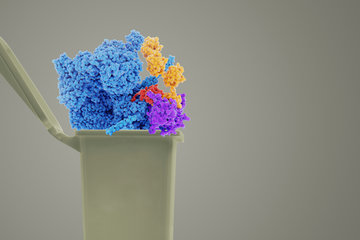Mystery of potential antibiotic target protein CydDC solved
The protein transports so-called heme molecules across the cell membrane
What looks like a tangle of colorful telephone wires are the 3D structures of bacterial proteins. To infect the host and survive in humans, they are essential for the bacterium: they help it to breathe and to generate energy. The function of a protein called CydDC in this process was a conundrum that kept researchers from all over the world busy for decades. Only by understanding the biochemical processes in bacteria, they can develop new drugs or improve medical therapies. Scientists at the Max Planck Institute of Biophysics, Virje University of Amsterdam in the Netherlands, Ghent University in Belgium and the University of Kent in the United Kingdom have now solved the mystery of CydDC by showing that it transports so-called heme molecules across the membrane.

Numerous human diseases are caused by bacteria. Even today, almost 100 years after the discovery of the first antibiotic penicillin, many of them are still lethal, tuberculosis being the most common virulent. As the number of multi-resistant bacterial strains continues to grow, treating infections with current antibiotics is becoming more and more difficult. Therefore, scientists constantly investigate bacterial molecules to identify new targets for drugs.
How do bacteria breathe in the human body
The team of researchers led by Schara Safarian at the Max Planck Institute of Biophysics has been studying the structure and function of cytochrome bd-type oxidases – a class of proteins found in many bacteria, including the pathogen that causes tuberculosis – for years. Cytochrome bd oxidases help the bacteria to breathe in the low-oxygen environment of the host body. They convert oxygen into water to generate energy from nutrients. For this process, cytochrome bd oxidases require heme molecules that can "trap" iron ions. These iron ions mediate the transfer of electrons between different molecules in living organisms and help to convert oxygen into water during respiration.
It has been known for decades that cytochrome bd oxidases also require a protein complex called CydDC to function properly. However, how CydDC is exactly involved in the bacterial energy metabolism has remained nebulous. Scientists speculated about a wide variety of functions until the team led by Schara Safarian finally solved the riddle: CydDC is a heme transporter. Like cytochrome bd oxidases, it resides in the inner membrane of bacteria. It transports heme molecules from the cytoplasm through this membrane to the other side like a watergate so that they can be incorporated into the assembling cytochrome bd oxidase, thus enabling cellular respiration.
"If we could switch off CydDC using drugs, respiration would no longer be possible and the bacteria would not be able to survive in humans," explains Di Wu, a postdoctoral researcher at the Max Planck Institute of Biophysics and first author of the study. "The human genome does not encode CydDC. That is why it would be a promising target for new antibiotics."
International multidisciplinary cooperation boosted the project
Key to the success in elucidating the function of CydDC was the interdisciplinary collaboration of experts from the Max Planck Institute of Biophysics and the universities in Amsterdam, Ghent and Kent, who combined experimental and computational methods. "The CydDC project was a sleeping giant and really took flight once the right team formed around it,” says project leader Schara Safarian.
Sonja Welsch and her team contributed significantly to the success of the project. She heads the Electron Microscopy Facility at the Max Planck Institute of Biophysics, and her years of experience and expert knowledge enabled the researchers to image CydDC complexes, which are only a few then-thousandths of a millimeter in size, using high-resolution electron microscopes in a remarkable large-scale, high-throughput approach. Powerful computer simulations then helped visualize how the CydDC transporters dynamically change their structure when taking up and releasing heme.












